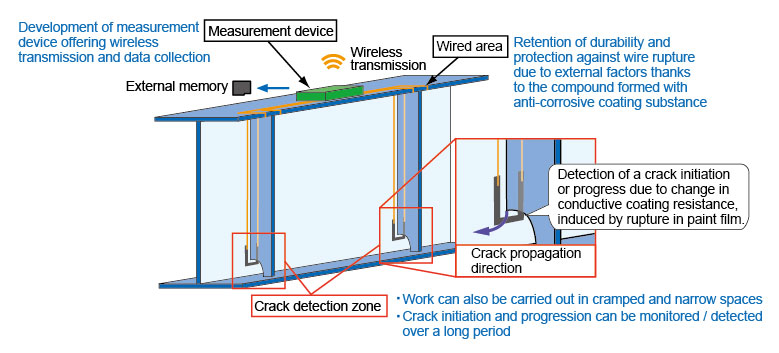5.Crack detection system for steel structures
- A practical system has been developed for detecting cracks on steel structures coated with conductive paint.
- This system is expected to increase crack detection efficiency.
Fatigue cracks appearing on steel structures are usually found in the course of scheduled visual inspections. Detecting such cracks with the naked eye however requires a high degree of skill and experience. As such there is demand for a method to detect crack initiation and propagation which does not rely on visual checking. Consequently, a crack detection system suited to steel structures was developed by focusing on conductive paint. The system comprises areas subject to checking for cracks which are coated in crack detection conductive paint, a gauge which measures the conductive coating’s electrical characteristics and wires connecting the areas (Fig.1). This crack detection system bears the following special features:
① The low resistance conductive coating for the wired area was developed separately. The various conductive coating materials were used to form a compound offering durability. The resulting product ensured that the durability in the crack detection area and the wired area possessed anti-corrosive properties which were equivalent to ordinary coatings.
② The conductive coating is very complex. Therefore, in order to ensure it is user-friendly and effective, it is suggested it should be applied in die-cut sheets or with an air-brush. This means that the produce can be applied as appropriate to form crack detection zones on actual bridges in spots identified as being vulnerable to cracking. The estimated time for applying the system to one such area is approximately 6 hours.
③ A wireless communication device was developed for transmitting data to be collected in an external memory (can be set to a random value). This means that variations in electrical characteristics in the conductive coating in the crack detection zone can be picked up remotely, removing the need for close inspection.
Tests on two steel structures located on a commercial railway line confirmed that this system can be applied in practice.

Fig.1 Illustration of an example of the crack detection system